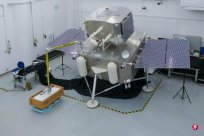
Hong Kong Polytechnic team develops key devices for research and development to develop key devices in the Hong Kong Polytechnic University team to help Chang'e Six 6Complete the world's first lunar back sampling.
Comprehensive reports from Hong Kong Zhongtong News Agency and Xinhua News Agency, China Chang'e 6 Moon probe completes the first lunar back -sample samples in human history. The key device for executing table sampling is developed by Hong Kong Polytechnic University.Hong Kong Richard ’s Friday (June 7) introduced at a press conference that how to break through the technical difficulties of the monthly sampling sampling.
Rong Qiliang, director of the Research and Research Center of Lida Deep Space, pointed out that due to the influence of land and moon rotation, humans cannot directly observe the monthly back and direct communication, and the monthly back environment is complex.Whether it is detection or landing, the difficulty and challenges of this sampling are greater than the front of the moon.
In order to cooperate with the monthly back work environment, the sampling time has been greatly shortened.Rong Qiliang said that the control algorithm and sampling strategy must be redesigned and optimized to increase the degree of sampling intelligence and automation.
It is reported that the entire sampling process is first sampled by the high -temperature near -camera camera installed in the sampler armor and B, and then pour the sample into the sample tank of the primary packaging system.When the sampling is completed, the packaging system is preserved to pack the moon sample.Under the navigation of a near -camera camera, the sample can accurately put the sample tank into the lifter and bring it back to the earth.The high -temperature near -temperature camera, sample tanks, and packaging agencies here are involved in the design and manufacturing.
Chang'e -6 rising device successfully completed the connection with the railor and the returner combination on June 6, and the container loaded with a lunar sample was safely transferred from the lift to the returner to the returned device.It is expected to bring the sample back to Earth on the 25th.
For Lida's application to obtain monthly soil research, Rong Qiliang said that he must apply and explain the use of research. He hopes to study the chemical ingredients of the moon soil.
Since 2010, Lida has been actively participating in the space exploration plan of mainland China, joined hands with the China Space Technology Research Institute to develop space instruments, and use advanced terrain measurement technology to help evaluate and select appropriate landing sites.No. 3, Chang'e No. 4, and Chang'e 5 lunar exploration mission and Tianwen No. 1 Mars mission were successful.



